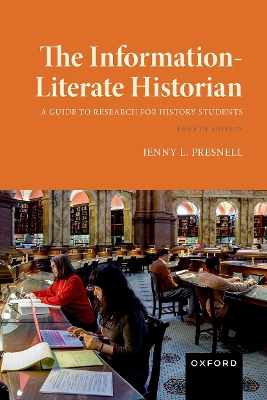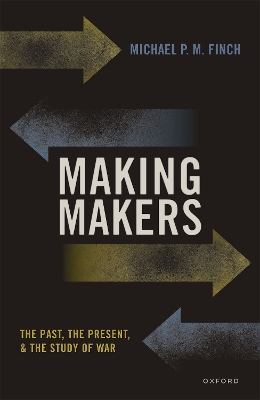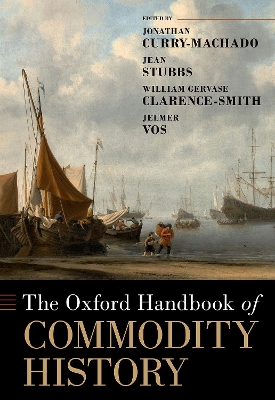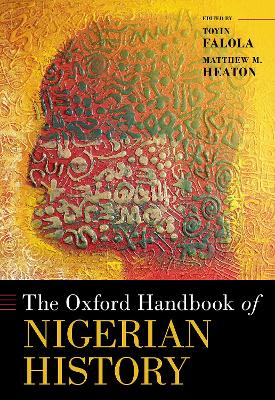Information-Literate Historian
 -10%
portes grátis
-10%
portes grátis
Information-Literate Historian
Presnell, Jenny L.
Oxford University Press Inc
10/2024
328
Mole
9780197749869
15 a 20 dias
Descrição não disponível.
Preface
New to This Edition
Introduction: What It Means to Be a Historian
Part I. Basic Research
1. Historians and the Research Process: Getting Started
How Scholarly Information Is Communicated
What Historians Do and How They Do It
How to Think Historically
Beginning Your Research
Where Do Viable and Interesting Topics Come From?
Developing a Question and Formulating an Argument
The Blueprint: Concept Maps, Storyboarding, and Outlines
Taking Notes
Creating Bibliographies and Documenting Sources
The Changing Nature of Historical Research and What Remains the Same
For Further Reading
2. Reference Resources
What Are Reference Resources and When Are They Useful?
How to Find Reference Resources
Types of Reference Resources
Encyclopedias
Bibliographies
Multivolume General Histories
Biographical Resources
Chronologies
Dictionaries, Etymologies, and Word Origins
Book Reviews
Using the Internet as a Reference Resource
Case Study: Using Reference Resources to Understand Herodotus
3. Searching Basics
Searching For Sources: The Beginnings
The Complexities of Searching for Information
Strategic Searching: Keyword vs Subject
Beginning a Search
Planning a Search
Alternative Searching: Using Facets to Limit a Search
Advanced Searching: Using Subjects and Controlled Vocabulary
Conclusion
Further Reading
4. Finding Monographs and Using Catalogs
What Is a Book? The Changing Nature of Monographs
When Are Books the Right Choice for Information?
How to Use a Book Artfully
Finding Monographs and Using Catalogs
Navigating a Library Portal/Finding the Catalog
How to Read an Online Catalog Record
Finding Monographs and Using Catalogs Outside of Your School
Case Study: Finding and Using Monographs: The Spread of Islam in Western Africa
5. Finding Journals, Magazines, and Newspapers: Using Indexes
What Are Periodicals (or Journals, Magazines, and Newspapers)?
Journals vs. Magazines
Commentary Periodicals
The Role of Newspapers in Secondary Historical Research
Journal Articles: The Core of Secondary Periodical Research
How to Read a Journal Article
How to Find Articles: Designing a Search and Using an Index
Using an Online Database: Historical Abstracts and America: History and Life
Entering a Keyword Search in Historical Abstracts
What You Will Get: Looking at Your Results
Selecting Other Indexes
JSTOR
Case Study: Searching for Periodical Articles: Canton Trade System
Selected Historical Indexes
Selected Periodical Indexes of Use to Historians
6. History and the Internet
The Internet and Research
When Is the Internet Appropriate for Historical Research?
Searching the Internet
Searching for Secondary Sources
Searching for Primary Sources
Historians Communicating: Using Listservs and Blogs for Information
Case Study: Using the Internet: Japanese Americans and Internment Camps
For Further Reading
7. Evaluating Your Sources
Why Evaluate Your Sources?
Basic Evaluation Criteria
Perspective and Bias: Historians and Interpretation
Scholarship or Propaganda?
"Fake" News and Misinformation
Case Study: Evaluating Sources: Holocaust Historians
For Further Reading
8. The Thrill of Discovery: Primary Sources
Definitions
Nature and Categories of Primary Sources
Planning Your Project with Primary Sources
Locating Primary Sources
Digitization and Electronic Access to Primary Sources
Published Sources for Mass Consumption
Books as Primary Sources
Magazines and Journals as Primary Sources
Newspapers as Primary Sources
Unpublished Sources and Manuscripts
Catalogs, Bibliographies, Directories, and Indexes for Manuscripts
Documents from Governments and Other Official Bodies
Indexes, Full-Text Sources, and Bibliographies of Government Documents
Directories/Bibliographies for Governments/Guides to Government Publications
Genealogy and Public Records
Guides for Genealogy and Public Records
Business Records
Directories and Resources
Oral History
Guide to Oral History Repositories
Material Culture: Buildings, Artifacts, and Objects
History before 1400: Ancient and Medieval Cultures and Those with Substantial Oral and Material Culture Traditions
Ancient History
Medieval European History
Indigenous Peoples, Former Colonial Nations, and African American History
Using Bibliographies to Locate Primary Sources
Bibliographies Containing References to Primary Sources
Evaluation of Primary Sources
Case Study: Finding Primary Sources: Tobacco through the Ages
For Further Reading
Bibliography of Advanced Indexes to Published Primary Sources
Part II. Advanced Research Techniques for Primary Sources
9. Maps: From Simple to Geographic Information Systems
Maps as Representations of Our World
A Short History of Maps and Cartography
Maps for Navigation and Commercial Use
Maps as Political Tools
Maps as Propaganda
Maps Marking Territory
Maps in War
Components of Modern Maps
Finding Maps
Categories of Historical Maps
Map Resources
Gazetteers
How to Read a Map
Questions to Ask When Reading a Map
Planning Your Own Map: Simple to Complex
For Further Reading
10. Beyond the Written Word: Finding, Evaluating, and Using Images, Motion Pictures, and Audio
The Role of Media in Historical Research: Images throughout History
Photography: Real Life Captured?
Art as Visual Media: Painting and Drawing
Moving Images: Fact and Fiction: Newsreels, Documentaries, Motion Pictures, and Television Programs
Searching for Visual Media
Collections of Historic Images
Search Engines and Meta-Search Engines for Images and Indexes to Image Collections
Images on the Internet: Some Cautions
Digital Video: Using Moving Images
Searching on the Web
Audio, Music, and Speech Resources
Searching for Audio Materials
Copyright
For Further Reading
11. Digital History and Big Data
What Digital History Is and Is Not
Approaches to Digital History
How to Perform Simple Digital Textual Analysis
Digital Textual Analysis Tools
Examples of Digital History Projects
Beginning Your Own Digital History Project
For Further Reading
12. Statistics: Quantifying History
A Society of Statistics
A Short History of the Evolution of Statistical Collection and Analysis: What Can You Expect to Find?
Categorizing Statistics: How They Are Collected and Organized
Demographics/Vital Statistics/Census Data
Economic Statistics
Social Statistics
Public Opinion and Consumer Preferences
Gleaning Statistics from Primary Sources
Finding Statistics
How to Think about the Sources
Search Strategies
Evaluating Statistics: Common Problems with Data Collection and Results
Questions to Evaluate Data
Data Problems: Signs That Something Is Wrong
Data Sets: Doing Your Own Thing
Selected Resources
Understanding Statistics
Collections of General Statistics/Statistical Abstracts
Almanacs and Yearbooks
Economic, Financial, and Commercial Statistics
General Demographics and Social Characteristics
Censuses
Polls/Public Opinion
Market Research
Major Social Surveys
Bibliographies and Indexes for Statistics
Finding and Using Data Sets
For Further Reading
Case Study: Contextualizing Statistics
Part III. Presenting Your Research
13. Presenting Your Research: Traditional Research Paper, Presentation,Poster, or Website?
Creating a Research Paper
Writing Style
Formulating an Argument
Paper Construction
Ebb and Flow of Paragraphs
Public Presenting
Oral, Slide, and Poster Presentations
Creating a Poster
Creating Websites for Historical Research
Historical and Scholarly Websites
Website Design: How to Begin
Other Forms of Presentation
Case Study: A Student Paper: "Americans and the Bomb"
For Further Reading
Appendix A: Citation Examples
Appendix B: Information Literacy Guidelines and Competencies for
Undergraduate History Students
Appendix C: Research Checklist
Index
New to This Edition
Introduction: What It Means to Be a Historian
Part I. Basic Research
1. Historians and the Research Process: Getting Started
How Scholarly Information Is Communicated
What Historians Do and How They Do It
How to Think Historically
Beginning Your Research
Where Do Viable and Interesting Topics Come From?
Developing a Question and Formulating an Argument
The Blueprint: Concept Maps, Storyboarding, and Outlines
Taking Notes
Creating Bibliographies and Documenting Sources
The Changing Nature of Historical Research and What Remains the Same
For Further Reading
2. Reference Resources
What Are Reference Resources and When Are They Useful?
How to Find Reference Resources
Types of Reference Resources
Encyclopedias
Bibliographies
Multivolume General Histories
Biographical Resources
Chronologies
Dictionaries, Etymologies, and Word Origins
Book Reviews
Using the Internet as a Reference Resource
Case Study: Using Reference Resources to Understand Herodotus
3. Searching Basics
Searching For Sources: The Beginnings
The Complexities of Searching for Information
Strategic Searching: Keyword vs Subject
Beginning a Search
Planning a Search
Alternative Searching: Using Facets to Limit a Search
Advanced Searching: Using Subjects and Controlled Vocabulary
Conclusion
Further Reading
4. Finding Monographs and Using Catalogs
What Is a Book? The Changing Nature of Monographs
When Are Books the Right Choice for Information?
How to Use a Book Artfully
Finding Monographs and Using Catalogs
Navigating a Library Portal/Finding the Catalog
How to Read an Online Catalog Record
Finding Monographs and Using Catalogs Outside of Your School
Case Study: Finding and Using Monographs: The Spread of Islam in Western Africa
5. Finding Journals, Magazines, and Newspapers: Using Indexes
What Are Periodicals (or Journals, Magazines, and Newspapers)?
Journals vs. Magazines
Commentary Periodicals
The Role of Newspapers in Secondary Historical Research
Journal Articles: The Core of Secondary Periodical Research
How to Read a Journal Article
How to Find Articles: Designing a Search and Using an Index
Using an Online Database: Historical Abstracts and America: History and Life
Entering a Keyword Search in Historical Abstracts
What You Will Get: Looking at Your Results
Selecting Other Indexes
JSTOR
Case Study: Searching for Periodical Articles: Canton Trade System
Selected Historical Indexes
Selected Periodical Indexes of Use to Historians
6. History and the Internet
The Internet and Research
When Is the Internet Appropriate for Historical Research?
Searching the Internet
Searching for Secondary Sources
Searching for Primary Sources
Historians Communicating: Using Listservs and Blogs for Information
Case Study: Using the Internet: Japanese Americans and Internment Camps
For Further Reading
7. Evaluating Your Sources
Why Evaluate Your Sources?
Basic Evaluation Criteria
Perspective and Bias: Historians and Interpretation
Scholarship or Propaganda?
"Fake" News and Misinformation
Case Study: Evaluating Sources: Holocaust Historians
For Further Reading
8. The Thrill of Discovery: Primary Sources
Definitions
Nature and Categories of Primary Sources
Planning Your Project with Primary Sources
Locating Primary Sources
Digitization and Electronic Access to Primary Sources
Published Sources for Mass Consumption
Books as Primary Sources
Magazines and Journals as Primary Sources
Newspapers as Primary Sources
Unpublished Sources and Manuscripts
Catalogs, Bibliographies, Directories, and Indexes for Manuscripts
Documents from Governments and Other Official Bodies
Indexes, Full-Text Sources, and Bibliographies of Government Documents
Directories/Bibliographies for Governments/Guides to Government Publications
Genealogy and Public Records
Guides for Genealogy and Public Records
Business Records
Directories and Resources
Oral History
Guide to Oral History Repositories
Material Culture: Buildings, Artifacts, and Objects
History before 1400: Ancient and Medieval Cultures and Those with Substantial Oral and Material Culture Traditions
Ancient History
Medieval European History
Indigenous Peoples, Former Colonial Nations, and African American History
Using Bibliographies to Locate Primary Sources
Bibliographies Containing References to Primary Sources
Evaluation of Primary Sources
Case Study: Finding Primary Sources: Tobacco through the Ages
For Further Reading
Bibliography of Advanced Indexes to Published Primary Sources
Part II. Advanced Research Techniques for Primary Sources
9. Maps: From Simple to Geographic Information Systems
Maps as Representations of Our World
A Short History of Maps and Cartography
Maps for Navigation and Commercial Use
Maps as Political Tools
Maps as Propaganda
Maps Marking Territory
Maps in War
Components of Modern Maps
Finding Maps
Categories of Historical Maps
Map Resources
Gazetteers
How to Read a Map
Questions to Ask When Reading a Map
Planning Your Own Map: Simple to Complex
For Further Reading
10. Beyond the Written Word: Finding, Evaluating, and Using Images, Motion Pictures, and Audio
The Role of Media in Historical Research: Images throughout History
Photography: Real Life Captured?
Art as Visual Media: Painting and Drawing
Moving Images: Fact and Fiction: Newsreels, Documentaries, Motion Pictures, and Television Programs
Searching for Visual Media
Collections of Historic Images
Search Engines and Meta-Search Engines for Images and Indexes to Image Collections
Images on the Internet: Some Cautions
Digital Video: Using Moving Images
Searching on the Web
Audio, Music, and Speech Resources
Searching for Audio Materials
Copyright
For Further Reading
11. Digital History and Big Data
What Digital History Is and Is Not
Approaches to Digital History
How to Perform Simple Digital Textual Analysis
Digital Textual Analysis Tools
Examples of Digital History Projects
Beginning Your Own Digital History Project
For Further Reading
12. Statistics: Quantifying History
A Society of Statistics
A Short History of the Evolution of Statistical Collection and Analysis: What Can You Expect to Find?
Categorizing Statistics: How They Are Collected and Organized
Demographics/Vital Statistics/Census Data
Economic Statistics
Social Statistics
Public Opinion and Consumer Preferences
Gleaning Statistics from Primary Sources
Finding Statistics
How to Think about the Sources
Search Strategies
Evaluating Statistics: Common Problems with Data Collection and Results
Questions to Evaluate Data
Data Problems: Signs That Something Is Wrong
Data Sets: Doing Your Own Thing
Selected Resources
Understanding Statistics
Collections of General Statistics/Statistical Abstracts
Almanacs and Yearbooks
Economic, Financial, and Commercial Statistics
General Demographics and Social Characteristics
Censuses
Polls/Public Opinion
Market Research
Major Social Surveys
Bibliographies and Indexes for Statistics
Finding and Using Data Sets
For Further Reading
Case Study: Contextualizing Statistics
Part III. Presenting Your Research
13. Presenting Your Research: Traditional Research Paper, Presentation,Poster, or Website?
Creating a Research Paper
Writing Style
Formulating an Argument
Paper Construction
Ebb and Flow of Paragraphs
Public Presenting
Oral, Slide, and Poster Presentations
Creating a Poster
Creating Websites for Historical Research
Historical and Scholarly Websites
Website Design: How to Begin
Other Forms of Presentation
Case Study: A Student Paper: "Americans and the Bomb"
For Further Reading
Appendix A: Citation Examples
Appendix B: Information Literacy Guidelines and Competencies for
Undergraduate History Students
Appendix C: Research Checklist
Index
Este título pertence ao(s) assunto(s) indicados(s). Para ver outros títulos clique no assunto desejado.
Preface
New to This Edition
Introduction: What It Means to Be a Historian
Part I. Basic Research
1. Historians and the Research Process: Getting Started
How Scholarly Information Is Communicated
What Historians Do and How They Do It
How to Think Historically
Beginning Your Research
Where Do Viable and Interesting Topics Come From?
Developing a Question and Formulating an Argument
The Blueprint: Concept Maps, Storyboarding, and Outlines
Taking Notes
Creating Bibliographies and Documenting Sources
The Changing Nature of Historical Research and What Remains the Same
For Further Reading
2. Reference Resources
What Are Reference Resources and When Are They Useful?
How to Find Reference Resources
Types of Reference Resources
Encyclopedias
Bibliographies
Multivolume General Histories
Biographical Resources
Chronologies
Dictionaries, Etymologies, and Word Origins
Book Reviews
Using the Internet as a Reference Resource
Case Study: Using Reference Resources to Understand Herodotus
3. Searching Basics
Searching For Sources: The Beginnings
The Complexities of Searching for Information
Strategic Searching: Keyword vs Subject
Beginning a Search
Planning a Search
Alternative Searching: Using Facets to Limit a Search
Advanced Searching: Using Subjects and Controlled Vocabulary
Conclusion
Further Reading
4. Finding Monographs and Using Catalogs
What Is a Book? The Changing Nature of Monographs
When Are Books the Right Choice for Information?
How to Use a Book Artfully
Finding Monographs and Using Catalogs
Navigating a Library Portal/Finding the Catalog
How to Read an Online Catalog Record
Finding Monographs and Using Catalogs Outside of Your School
Case Study: Finding and Using Monographs: The Spread of Islam in Western Africa
5. Finding Journals, Magazines, and Newspapers: Using Indexes
What Are Periodicals (or Journals, Magazines, and Newspapers)?
Journals vs. Magazines
Commentary Periodicals
The Role of Newspapers in Secondary Historical Research
Journal Articles: The Core of Secondary Periodical Research
How to Read a Journal Article
How to Find Articles: Designing a Search and Using an Index
Using an Online Database: Historical Abstracts and America: History and Life
Entering a Keyword Search in Historical Abstracts
What You Will Get: Looking at Your Results
Selecting Other Indexes
JSTOR
Case Study: Searching for Periodical Articles: Canton Trade System
Selected Historical Indexes
Selected Periodical Indexes of Use to Historians
6. History and the Internet
The Internet and Research
When Is the Internet Appropriate for Historical Research?
Searching the Internet
Searching for Secondary Sources
Searching for Primary Sources
Historians Communicating: Using Listservs and Blogs for Information
Case Study: Using the Internet: Japanese Americans and Internment Camps
For Further Reading
7. Evaluating Your Sources
Why Evaluate Your Sources?
Basic Evaluation Criteria
Perspective and Bias: Historians and Interpretation
Scholarship or Propaganda?
"Fake" News and Misinformation
Case Study: Evaluating Sources: Holocaust Historians
For Further Reading
8. The Thrill of Discovery: Primary Sources
Definitions
Nature and Categories of Primary Sources
Planning Your Project with Primary Sources
Locating Primary Sources
Digitization and Electronic Access to Primary Sources
Published Sources for Mass Consumption
Books as Primary Sources
Magazines and Journals as Primary Sources
Newspapers as Primary Sources
Unpublished Sources and Manuscripts
Catalogs, Bibliographies, Directories, and Indexes for Manuscripts
Documents from Governments and Other Official Bodies
Indexes, Full-Text Sources, and Bibliographies of Government Documents
Directories/Bibliographies for Governments/Guides to Government Publications
Genealogy and Public Records
Guides for Genealogy and Public Records
Business Records
Directories and Resources
Oral History
Guide to Oral History Repositories
Material Culture: Buildings, Artifacts, and Objects
History before 1400: Ancient and Medieval Cultures and Those with Substantial Oral and Material Culture Traditions
Ancient History
Medieval European History
Indigenous Peoples, Former Colonial Nations, and African American History
Using Bibliographies to Locate Primary Sources
Bibliographies Containing References to Primary Sources
Evaluation of Primary Sources
Case Study: Finding Primary Sources: Tobacco through the Ages
For Further Reading
Bibliography of Advanced Indexes to Published Primary Sources
Part II. Advanced Research Techniques for Primary Sources
9. Maps: From Simple to Geographic Information Systems
Maps as Representations of Our World
A Short History of Maps and Cartography
Maps for Navigation and Commercial Use
Maps as Political Tools
Maps as Propaganda
Maps Marking Territory
Maps in War
Components of Modern Maps
Finding Maps
Categories of Historical Maps
Map Resources
Gazetteers
How to Read a Map
Questions to Ask When Reading a Map
Planning Your Own Map: Simple to Complex
For Further Reading
10. Beyond the Written Word: Finding, Evaluating, and Using Images, Motion Pictures, and Audio
The Role of Media in Historical Research: Images throughout History
Photography: Real Life Captured?
Art as Visual Media: Painting and Drawing
Moving Images: Fact and Fiction: Newsreels, Documentaries, Motion Pictures, and Television Programs
Searching for Visual Media
Collections of Historic Images
Search Engines and Meta-Search Engines for Images and Indexes to Image Collections
Images on the Internet: Some Cautions
Digital Video: Using Moving Images
Searching on the Web
Audio, Music, and Speech Resources
Searching for Audio Materials
Copyright
For Further Reading
11. Digital History and Big Data
What Digital History Is and Is Not
Approaches to Digital History
How to Perform Simple Digital Textual Analysis
Digital Textual Analysis Tools
Examples of Digital History Projects
Beginning Your Own Digital History Project
For Further Reading
12. Statistics: Quantifying History
A Society of Statistics
A Short History of the Evolution of Statistical Collection and Analysis: What Can You Expect to Find?
Categorizing Statistics: How They Are Collected and Organized
Demographics/Vital Statistics/Census Data
Economic Statistics
Social Statistics
Public Opinion and Consumer Preferences
Gleaning Statistics from Primary Sources
Finding Statistics
How to Think about the Sources
Search Strategies
Evaluating Statistics: Common Problems with Data Collection and Results
Questions to Evaluate Data
Data Problems: Signs That Something Is Wrong
Data Sets: Doing Your Own Thing
Selected Resources
Understanding Statistics
Collections of General Statistics/Statistical Abstracts
Almanacs and Yearbooks
Economic, Financial, and Commercial Statistics
General Demographics and Social Characteristics
Censuses
Polls/Public Opinion
Market Research
Major Social Surveys
Bibliographies and Indexes for Statistics
Finding and Using Data Sets
For Further Reading
Case Study: Contextualizing Statistics
Part III. Presenting Your Research
13. Presenting Your Research: Traditional Research Paper, Presentation,Poster, or Website?
Creating a Research Paper
Writing Style
Formulating an Argument
Paper Construction
Ebb and Flow of Paragraphs
Public Presenting
Oral, Slide, and Poster Presentations
Creating a Poster
Creating Websites for Historical Research
Historical and Scholarly Websites
Website Design: How to Begin
Other Forms of Presentation
Case Study: A Student Paper: "Americans and the Bomb"
For Further Reading
Appendix A: Citation Examples
Appendix B: Information Literacy Guidelines and Competencies for
Undergraduate History Students
Appendix C: Research Checklist
Index
New to This Edition
Introduction: What It Means to Be a Historian
Part I. Basic Research
1. Historians and the Research Process: Getting Started
How Scholarly Information Is Communicated
What Historians Do and How They Do It
How to Think Historically
Beginning Your Research
Where Do Viable and Interesting Topics Come From?
Developing a Question and Formulating an Argument
The Blueprint: Concept Maps, Storyboarding, and Outlines
Taking Notes
Creating Bibliographies and Documenting Sources
The Changing Nature of Historical Research and What Remains the Same
For Further Reading
2. Reference Resources
What Are Reference Resources and When Are They Useful?
How to Find Reference Resources
Types of Reference Resources
Encyclopedias
Bibliographies
Multivolume General Histories
Biographical Resources
Chronologies
Dictionaries, Etymologies, and Word Origins
Book Reviews
Using the Internet as a Reference Resource
Case Study: Using Reference Resources to Understand Herodotus
3. Searching Basics
Searching For Sources: The Beginnings
The Complexities of Searching for Information
Strategic Searching: Keyword vs Subject
Beginning a Search
Planning a Search
Alternative Searching: Using Facets to Limit a Search
Advanced Searching: Using Subjects and Controlled Vocabulary
Conclusion
Further Reading
4. Finding Monographs and Using Catalogs
What Is a Book? The Changing Nature of Monographs
When Are Books the Right Choice for Information?
How to Use a Book Artfully
Finding Monographs and Using Catalogs
Navigating a Library Portal/Finding the Catalog
How to Read an Online Catalog Record
Finding Monographs and Using Catalogs Outside of Your School
Case Study: Finding and Using Monographs: The Spread of Islam in Western Africa
5. Finding Journals, Magazines, and Newspapers: Using Indexes
What Are Periodicals (or Journals, Magazines, and Newspapers)?
Journals vs. Magazines
Commentary Periodicals
The Role of Newspapers in Secondary Historical Research
Journal Articles: The Core of Secondary Periodical Research
How to Read a Journal Article
How to Find Articles: Designing a Search and Using an Index
Using an Online Database: Historical Abstracts and America: History and Life
Entering a Keyword Search in Historical Abstracts
What You Will Get: Looking at Your Results
Selecting Other Indexes
JSTOR
Case Study: Searching for Periodical Articles: Canton Trade System
Selected Historical Indexes
Selected Periodical Indexes of Use to Historians
6. History and the Internet
The Internet and Research
When Is the Internet Appropriate for Historical Research?
Searching the Internet
Searching for Secondary Sources
Searching for Primary Sources
Historians Communicating: Using Listservs and Blogs for Information
Case Study: Using the Internet: Japanese Americans and Internment Camps
For Further Reading
7. Evaluating Your Sources
Why Evaluate Your Sources?
Basic Evaluation Criteria
Perspective and Bias: Historians and Interpretation
Scholarship or Propaganda?
"Fake" News and Misinformation
Case Study: Evaluating Sources: Holocaust Historians
For Further Reading
8. The Thrill of Discovery: Primary Sources
Definitions
Nature and Categories of Primary Sources
Planning Your Project with Primary Sources
Locating Primary Sources
Digitization and Electronic Access to Primary Sources
Published Sources for Mass Consumption
Books as Primary Sources
Magazines and Journals as Primary Sources
Newspapers as Primary Sources
Unpublished Sources and Manuscripts
Catalogs, Bibliographies, Directories, and Indexes for Manuscripts
Documents from Governments and Other Official Bodies
Indexes, Full-Text Sources, and Bibliographies of Government Documents
Directories/Bibliographies for Governments/Guides to Government Publications
Genealogy and Public Records
Guides for Genealogy and Public Records
Business Records
Directories and Resources
Oral History
Guide to Oral History Repositories
Material Culture: Buildings, Artifacts, and Objects
History before 1400: Ancient and Medieval Cultures and Those with Substantial Oral and Material Culture Traditions
Ancient History
Medieval European History
Indigenous Peoples, Former Colonial Nations, and African American History
Using Bibliographies to Locate Primary Sources
Bibliographies Containing References to Primary Sources
Evaluation of Primary Sources
Case Study: Finding Primary Sources: Tobacco through the Ages
For Further Reading
Bibliography of Advanced Indexes to Published Primary Sources
Part II. Advanced Research Techniques for Primary Sources
9. Maps: From Simple to Geographic Information Systems
Maps as Representations of Our World
A Short History of Maps and Cartography
Maps for Navigation and Commercial Use
Maps as Political Tools
Maps as Propaganda
Maps Marking Territory
Maps in War
Components of Modern Maps
Finding Maps
Categories of Historical Maps
Map Resources
Gazetteers
How to Read a Map
Questions to Ask When Reading a Map
Planning Your Own Map: Simple to Complex
For Further Reading
10. Beyond the Written Word: Finding, Evaluating, and Using Images, Motion Pictures, and Audio
The Role of Media in Historical Research: Images throughout History
Photography: Real Life Captured?
Art as Visual Media: Painting and Drawing
Moving Images: Fact and Fiction: Newsreels, Documentaries, Motion Pictures, and Television Programs
Searching for Visual Media
Collections of Historic Images
Search Engines and Meta-Search Engines for Images and Indexes to Image Collections
Images on the Internet: Some Cautions
Digital Video: Using Moving Images
Searching on the Web
Audio, Music, and Speech Resources
Searching for Audio Materials
Copyright
For Further Reading
11. Digital History and Big Data
What Digital History Is and Is Not
Approaches to Digital History
How to Perform Simple Digital Textual Analysis
Digital Textual Analysis Tools
Examples of Digital History Projects
Beginning Your Own Digital History Project
For Further Reading
12. Statistics: Quantifying History
A Society of Statistics
A Short History of the Evolution of Statistical Collection and Analysis: What Can You Expect to Find?
Categorizing Statistics: How They Are Collected and Organized
Demographics/Vital Statistics/Census Data
Economic Statistics
Social Statistics
Public Opinion and Consumer Preferences
Gleaning Statistics from Primary Sources
Finding Statistics
How to Think about the Sources
Search Strategies
Evaluating Statistics: Common Problems with Data Collection and Results
Questions to Evaluate Data
Data Problems: Signs That Something Is Wrong
Data Sets: Doing Your Own Thing
Selected Resources
Understanding Statistics
Collections of General Statistics/Statistical Abstracts
Almanacs and Yearbooks
Economic, Financial, and Commercial Statistics
General Demographics and Social Characteristics
Censuses
Polls/Public Opinion
Market Research
Major Social Surveys
Bibliographies and Indexes for Statistics
Finding and Using Data Sets
For Further Reading
Case Study: Contextualizing Statistics
Part III. Presenting Your Research
13. Presenting Your Research: Traditional Research Paper, Presentation,Poster, or Website?
Creating a Research Paper
Writing Style
Formulating an Argument
Paper Construction
Ebb and Flow of Paragraphs
Public Presenting
Oral, Slide, and Poster Presentations
Creating a Poster
Creating Websites for Historical Research
Historical and Scholarly Websites
Website Design: How to Begin
Other Forms of Presentation
Case Study: A Student Paper: "Americans and the Bomb"
For Further Reading
Appendix A: Citation Examples
Appendix B: Information Literacy Guidelines and Competencies for
Undergraduate History Students
Appendix C: Research Checklist
Index
Este título pertence ao(s) assunto(s) indicados(s). Para ver outros títulos clique no assunto desejado.







